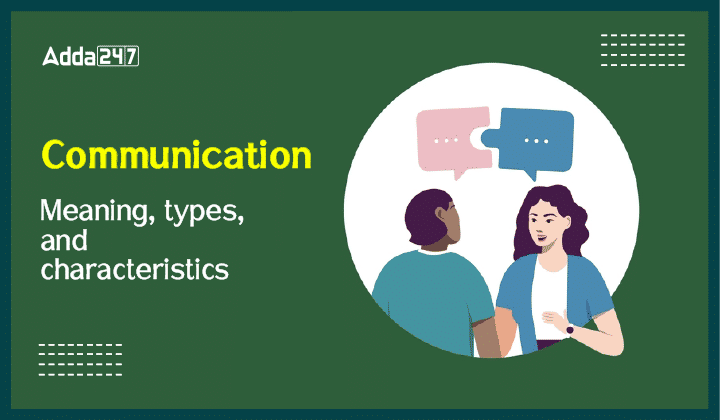Table of Contents
“Communication” is derived from the Latin word “communis” which implies commonness. It is the process of sharing information, thoughts, messages, facts, ideas, opinions, emotions and understanding from one person to another person.
- According to Newman and Summer, “Communication is an exchange of facts, ideas, opinions or emotions by two or more persons”.
- According to Koontz and ‘O’Donnell, “Communication is an intercourse by words, letter symbols or messages and is a way that one organization member shares meaning and understanding with another.”
Hence, communication is an exchange of ideas, opinions, facts or emotions by two or more individuals.
Characteristics of Communication
Communication is the process of exchanging thoughts and ideas. The following are the major characteristics of communication:
- More than one person: It is the foremost need of communication there must be an existence of more than one person for the exchange of ideas and opinions. Communication cannot take place with the presence of a single individual. There is a need to have both sender and receiver for effective communication to take place.
- Exchange of Ideas/opinions and thoughts: Communication cannot be done without the presence of ideas opinions and thoughts. If a person is having an idea in his or her mind then he or she needs to exchange those ideas with another person. Hence, for communication, there must be an exchange of ideas, and feelings among two or more persons.
- Communication can be Direct and Indirect: Communication can be direct or indirect also. During direct communication, ideas can be shared face-to-face with each other. While Indirect Communication is used to interact via other means.
- Mutual Understanding: For effective communication, mutual understanding plays a vital role. It means that the receiver should receive the information in the identical spirit with which the sender wants to communicate the message.
- Dynamic process: Communication is affected by the mood and thinking of the sender and receiver. The way a message is conveyed and received depends upon the active sensory organs of the communicator and receiver.
- The primary purpose is to get a response: The aim of effective communication is to get feedback from the receiver and motivate him or her to give the response. It helps to make communication better an effective.
Types of Communication
There are numerous ways through which people communicate. Majorly communication can be of two types:
On the basis of Communication Channels
- Verbal communication: The kind of communication where a communicator can communicate their messages and opinions using spoken and written words. In simple words, when words are used to express feelings and thoughts, this is referred to as verbal communication.
- Oral communication: It is the process of transmitting knowledge verbally and ideas from one person or group to another.
- Written communication: Written communication is an exchange of ideas and opinions via written messages which are more formal than oral communication.
- Non-Verbal communication: It is the communication of messages or ideas through eye contact, gestures, posture, facial expressions, use of objects and body language. Here, the communicator uses kinesics and social cues etc.
On the basis of organisational structure:
| Communication | Defination |
| Formal Communication |
It is the exchange of information between two or more people within a specified structure of an organisation using official channels of communication. The following are the major features of formal communication:
|
| Informal Communication |
This is casual communication between two or more persons. Below are the major features of informal communication:
|
On the basis of the relationship:
- Intrapersonal Communication: Communication that took place in the mind of the individual is called intrapersonal communication. This includes self-talk recalling the facts imagination and internal vocalisation.
- Transpersonal Communication: This kind of communication takes place to enhance spirituality in the person and happens in the person’s spiritual domain.
- Interpersonal Communication: This interpersonal communication is an exchange of ideas and feelings between two or more persons through different verbal methods.
- Group Communication: The type of communication that took place between small or large groups like in the classroom or in the club is called group communication.
- Mass Communication: Mass communication is a process where we exchange information through mass media with a large population. Channels through which media communication can happen our newspapers magazines books films and the internet
On the basis of the direction
- Vertical communication – This is very similar to formal communication and follows an upward or downward direction
- Horizontal communication- This communication takes place between more than one person who is working on the same levels in an organization. This is also known as lateral communication
- Upward communication – The communication process through which information is supplied from the lower level to the upper level is called to avoid communication. This type of organization occurs when organizations provide freedom to their employees where they can share their ideas freely with the organization heads. Example feedback provided by employees to their supervisor
- Downward communication – This communication follows top to bottom Broach where ideas and opinions are conveyed from the upper level to the lower level. Example communication takes place between superiors and subordinates via the chain of command.
- Diagonal communication – Communication that takes place between different levels of persons is called diagonal communication. Example communication between the marketing manager and production supervisor. This kind of communication can strengthen the relationship between superiors and subordinates.
In a nutshell, communication can help us to convey our opinions and thoughts to others. The type of communication we use all depends on the need and the aim of the idea that the communicator wants to convey.
Download Communication: Meaning, Types, and Characteristics PDF
| UGC NET Important Links | |
| UGC NET 2023 Notification | UGC NET New Syllabus |
| UGC NET Previous Year Papers | UGC NET Teacher Salary |
| UGC NET Admit Card | UGC NET Answer Key |




 MAHA TAIT Result 2025 Out Soon @mscepune...
MAHA TAIT Result 2025 Out Soon @mscepune...
 JKSET Syllabus and Exam Pattern 2025, Do...
JKSET Syllabus and Exam Pattern 2025, Do...
 MPPSC Assistant Professor Selection Proc...
MPPSC Assistant Professor Selection Proc...




